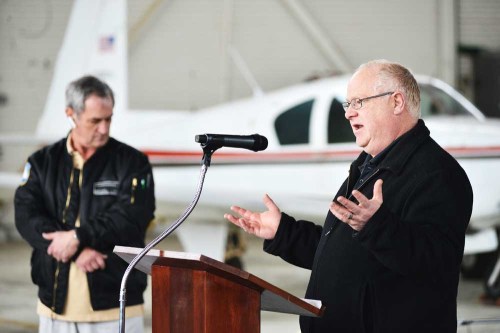ArcticShark takes flight at Pendleton UAS Range
Published 3:16 pm Wednesday, March 8, 2017

- Marcel Piet, president of UAS services for ArgenTech Solutions, talks about how his company's involvement with the ArticShark program on Wednesday at the Eastern Oregon Regional Airport.
Dark clouds and drizzle did not hinder test flights Wednesday of the largest drone ever to fly at the Pendleton Unmanned Aerial Systems Range.
The ArcticShark, a 625-pound behemoth with a 22-foot wingspan, is destined to prowl the clouds over the Arctic coast of Alaska carrying more than a dozen instruments to gather some of the most sophisticated climate data ever recorded.
Trending
But first, researchers must fine-tune the aircraft and get their pilots up to speed in preparation for the 2018 mission. Flight testing and training began Feb. 27 at the Pendleton UAS Range, led by the Pacific Northwest National Laboratory in Richland, Washington.
Project leaders hosted an open house Wednesday afternoon at the Eastern Oregon Regional Airport to give members of the public an up-close look at the ArcticShark.
“I think we’re making history here,” said Beat Schmid, associate director of the Atmospheric Sciences & Global Change Division at PNNL.
Developed by Navmar Applied Sciences Corporation, an engineering firm based in Pennsylvania, the ArcticShark was originally created for military applications. It is based on the TigerShark model used for surveillance and reconnaissance by the U.S. Navy.
Instead, the system was revamped for the Department of Energy as a climate measuring tool. Schmid, who manages the Atmospheric Radiation Measurement aerial facility at PNNL, said the agency has pushed for some time to determine what value drones can add to their research.
“You can take a little more risk with an unmanned aircraft,” he said.
Trending
PNNL has flown smaller drones before at the Pendleton range, which is part of the Pan-Pacific UAS Test Range Complex and one of six official test sites across the country designated by the Federal Aviation Administration.
The ArcticShark, however, is a different animal. It took about a year to get FAA approval to fly the vehicle because of its size and capabilities.
Marcel Piet, president of UAS services for ArgenTech Solutions in Vancouver, Washington, said his company provided technical assistance for getting the operation certified. Normally, a drone license will allow flights up to 400 feet for vehicles under 55 pounds, but the ArcticShark is more than 10 times as big and able to fly up to 15,000 feet. By comparison, most commercial jets cruise at an altitude of 33,000 feet.
Piet said the FAA is famously risk-averse, and it was a lengthy process to prove PNNL could handle the unconventional drone.
“You have to demonstrate to the FAA you know how to fly,” Piet said. “They want to make sure you know what you’re doing.”
The Department of Energy took ownership of the ArcticShark on Sunday, and pilots are now being trained how to monitor the aircraft from a specially manufactured mobile flight center on the ground. The drone is equipped with a 60-horsepower engine and can fly up to eight hours at a time.
Both wings are capable of holding 50 pounds of laser mapping instruments, which will be used to take precise measurements of things like water vapor, carbon dioxide gas and aerosol particles in the Arctic atmosphere.
Schmid described the Arctic as one of the planet’s most sensitive regions, a place where climate change is happening at a much faster rate than previously predicted. The data captured by ArcticShark will allow scientists to better understand the processes at work.
“It’s ultimately, of course, about better predicting the Earth’s climate,” Schmid said.
Testing will continue on and off at the Pendleton range throughout the year before ArcticShark is sent to an atmospheric research base on the North Slope of Alaska.
Darryl Abling, Pendleton UAS Range manager, said it is their biggest project to date. More potential clients have also shown interest in the range, he said, but couldn’t specify.
“For the city and the range, ultimately we desire to become a high-tech UAV center,” Abling said.
Steve Chrisman, Pendleton’s economic development director and airport manager, said the city is excited to capitalize on new opportunities the drone industry may bring to the area.
“We really think this is just the front edge of an incredible economic development opportunity,” he said.
———
Contact George Plaven at gplaven@eastoregonian.com or 541-966-0825.









